Wagashi (和菓子) is Japanese traditional sweets. It is part of traditional Japanese culture, and is deeply associated with the four seasons and events in Japan. Not only are they delicious, but their beautiful appearance is one of the most attractive aspects of Wagashi.
In this article, we introduce the history of Wagashi which started in the Jomon period, as well as its appeal. We also answer the biggest question, “How is Wagashi different from Western sweets?”, so have a read to deepen your knowledge of Japanese culture.
Table of Contents
- What is Wagashi?
- The History of Wagashi
- How is Wagashi different from Western confectionaries?
- The 3 Categories of Wagashi
- Wagashi Associated with Seasons & Celebrations
- Popular Wagashi to Try
- The Modern Take on Wagashi
What is Wagashi?

Wagashi (和菓子) is traditional Japanese sweets and confectionaries.
-
和 Wa meaning “Japanese” or “Japanese-style”.
-
菓子 Kashi, or お菓子 Okashi, meaning “confectionary”, “sweets”, “candy”, and “cake”.
Wagashi is characterized by its gentle sweetness and lovely appearance. Aside from being eaten on a daily basis as snacks or dessert, they are also an essential part of seasonal events and celebrations. In Japan, Wagashi is enjoyed by children and adults alike.
Compared to Western confectionaries, the sweetness is subdued (as are many drinks and sweets in Japan), so older people enjoy it as well. Wagashi is low in calories because it does not contain much animal fat from butter or cream, making it a healthier option. For example, 100g of shortcake contains about 350 kcal, while 100g of daifuku contains about 240 kcal. Besides that, another characteristic of Wagashi is the use of healthy ingredients such as soybeans, red beans, and glutinous rice. Many other ingredients with high dietary fiber content are also used, which is believed to contain health and beautifying benefits.
What is the difference between Wagashi, Dagashi, and Okashi?

You may have heard the above 3 Japanese terms before. They all refer to sweets or candy, so how are they different?
-
Wagashi (和菓子), as explained above, is traditional Japanese sweets and confectionaries.
-
Dagashi (駄菓子) is penny candy that is sold at Dagashi-ya (駄菓子屋), specialty penny candy stores.
-
Okashi (お菓子), or Kashi (菓子), is the general Japanese term for sweets and confectionaries including Wagashi and Dagashi above.
Nowadays, Okashi is used to refer to popular snacks like Pocky, Kit Kat, Pretz, candy, chocolates, etc.
that can be easily found in supermarkets, souvenir shops, and convenience stores.
Writer's Pick
The History of Wagashi
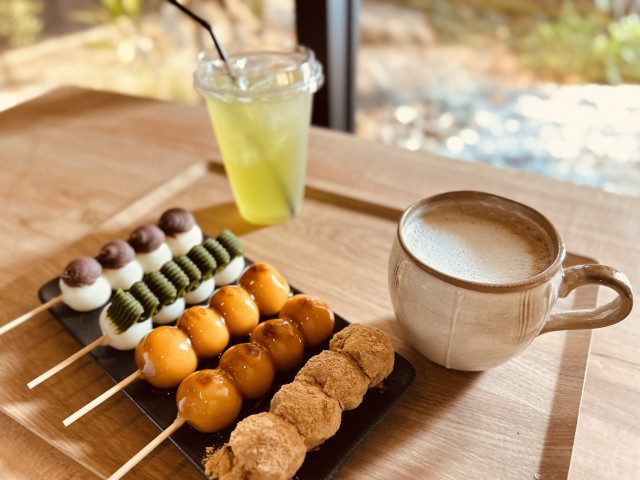
Wagashi was created in close association with Japanese history with most wagashi having been created during the Edo period, though Wagashi is believed to have first started in the prehistoric Jomon period. Influenced by exchanges with foreign culture, created by incorporating various ingredients, and connected deeply with the seasons and events in Japan, there are many Wagashi that are popular to this day.
Dango from the Jomon Period
The history of Wagashi is believed to have started more than 2,000 years ago during the Jomon period when people lived in pit dwellings and started to use earthenware and stone tools. The very first dango was said to have been created during this time, and was made by crushing tree nuts, and rolling them into balls after cleaning them in water.
Fruits and Nuts in the Yayoi Period

During Japan’s Yayoi period, partaking in the sweetness of fruits was considered a special treat, and snacking on fruits and nuts became customary. This is believed to be the origin of the term Kashi (果子) for fruit, that eventually became Kashi (菓子) for confectionery and sweets. In Japan at that time, chestnuts and persimmons were cultivated, and with the development of food culture, the harvest fruits were dried and preserved, then crushed into small pieces with tools.
After this, progress was recorded with the creation of mochi (もち), said to be the oldest processed food in Japan. Made from rice, which was a valuable ingredient at the time, mochi was treated as sacred.
Even after the birth of mochi and dango, pure sugar remained a luxury item that was out of reach of the common people, and so fruit continued to be at the heart of sweets.
Amazura (Sweet Kudzu) as a Substitute for Sugar
Amazura (甘葛) is a sweetener made by boiling down the sap of ivy, and was used as a substitute for sugar. In the Pillow Book written by Sei Shonagon in the Heian period, there was a dessert that was described as “adding amazura to kakigori (shaved ice)”, which suggests that it was used as a sweetener.
At that time, Amazura was a luxury item that was presented to the Shogunate and the Imperial Court. It is also believed that rice sprouts (米もやし kome moyashi), rice that has sprouted, were used to make candy by converting starch into sugar. Later, sugar was introduced to Japan and became widely used in the Edo period.
Karakudamono (Chinese Originated Pastries) Influenced Wagashi
Karakudamono (唐果物) is made from kneaded then fried rice, barley or soybeans. It is believed to have been introduced by the Japanese envoys that went to China from the Asuka to Heian periods. Each type of karakudamono had its own distinctive shape and was called “Baishi (梅枝)”, “Toushi (桃子)”, “Kakko (餲餬)”, etc. Karakudamono is said to have had a major influence on Wagashi.
How is Wagashi different from Western confectionaries?

Western confectionaries are called Yougashi (洋菓子) in Japanese.
-
洋 You meaning “Western”, “European”.
-
菓子 Kashi meaning “confectionary”, “sweets”, “candy”, and “cake”.
Yougashi, aka Western Confectionaries, are a part of Western culture that was introduced to Japan in the Taisho period. Let’s have a look at the differences between Wagashi and Yougashi below.
Different Ingredients Used
Wagashi are mainly made from rice, barley, beans, and etc. plant-based ingredients along with lots of sugar and starch which gives it the characteristic of having a low calorie count despite its high sugar content. On the other hand, Western confectionaries has high fat and calorie content due to its usage of animal-based ingredients like eggs, butter, milk, and cream.
Difference in Taste
Wagashi is characterised by having a gentle sweetness derived from its usage of sugar types like caster sugar, Wasanbon sugar, and brown sugar. In recent years, some wagashi have been made with fruit, such as strawberry daifuku, but the sweetness is still on the lighter side. Western confectionaries, on the other hand, are characterised by a variety of flavours, such as fresh cream, chocolate, custard cream, and fruits.
Making Wagashi is a Manual Process
Making Wagashi is mainly a manual process. The kneading and shaping of ingredients is mostly done by hand. Western confectionaries on the other hand make full use of electric equipment such as mixers and ovens.
Different Appearances for Both
Wagashi often represent the four seasons, such as seasonal flowers, flora and fauna. They are also characterised by small round shapes, such as “Nerikiri”, which are made one by one by craftsmen. Western confectionaries, on the other hand, are gorgeously decorated with fresh cream, chocolate, powder and come in a variety of sizes.
The 3 Categories of Wagashi
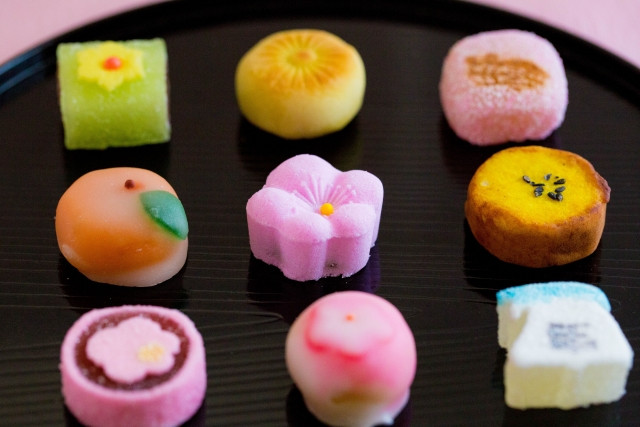
Wagashi can be divided into 3 broad categories based on the amount of water they contain and their preservation properties.
1. Namagashi 生菓子
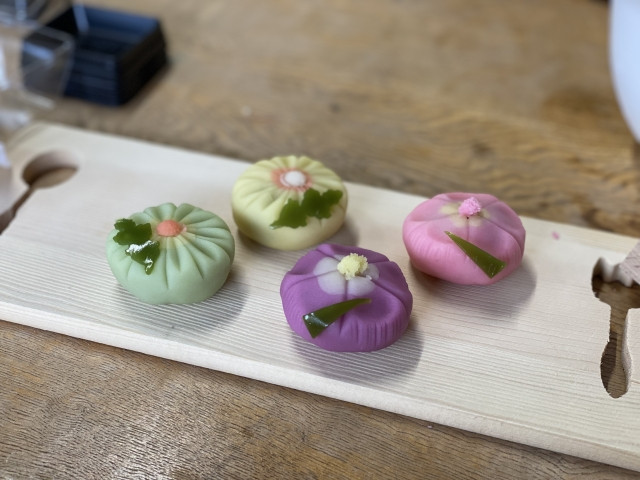
Namagashi (生菓子; fresh confectionaries) refers to Wagashi that contain more than 30% water content. Due to their high water content, they are easily damaged and cannot be stored for long periods of time. In addition, many of them are made from mochi or red bean paste which becomes hard over time.
Typical examples of Namagashi are as follows:
-
Mochi Type : Ohagi, Daifuku, Kusa-mochi, Kashiwa-mochi
-
Baked Type : Dorayaki, Kintsuba, Castella, Imagawa-yaki
-
Kake Type : Anmitsu
-
Steamed Type : Uirou, Warabi-mochi, Kuzu-mochi, Sake Manju
-
Red Bean Type : Zenzai
-
Fried Type : Red Bean Donut, Mooncake (Geppei)
-
Liquid Type : Yokan, Mizu-Yokan, Tokoroten
-
Neri Type : Nerikiri, Gyuhi
2. Han-Namagashi 半生菓子

Han-Namagashi (半生菓子; half-dry confectionery) is Wagashi that contains 10~30% water content. They can last from 3 days to a week, which is longer than Namagashi, making them suitable for gift-giving. However, some are closer to Namagashi which has a shorter expiry date, so make sure to check carefully.
Examples of Han-Namagashi are as follows:
-
Baked Type : Anpan (Red Bean Bread), Momoyama, Soushi
-
Kake Type : Amanatto (Sugared Red Beans)
-
Red Bean Type : Ishigoromo, Zenzai
-
Liquid Type : Yokan, Kangoori, Sugared Ginger, Mizorekan
-
Neri Type : Gyuhi, Kibi-Dango, Yubeshi
-
Steamed Type : Kurikinton, Kirizansho
-
Sandwich Type : Monaka, Suhama, Fresh Yatsuhashi
3. Higashi 干菓子

Higashi (干菓子; dried confectionary) are Wagashi with moisture content of less than 10%. Due to their lower water content, they can be stored for a long time and some can last several months. Savoury snacks such as senbei (rice crackers), persimmon seeds, and arare are also categorised as Higashi.
Here are some examples of Higashi:
-
Savoury Type : Senbei, Bolo, Arare, Persimmon Seeds, Caramelo
-
Candy Type : Amedama, Chitose-Ame, Konpeito, Aruheitou
-
Molded Type : Rakugan, Unpei
-
Kake Type : Okoshi, Sugar Preserved, Gokabou
-
Fried Type : Karintou
-
Pressed Type : Shiogama, Murasame
Wagashi can be broadly classified according to their water content, but even this can be difficult at times. Some Wagashi with the same name can be in 2 categories. For example, Yokan and Gyuuhi can be classified as Namagashi if made soft, and as Han-Namagashi if made harder. They have different storage periods, so it is important to check the expiry dates for individual products rather than by the name of the confectionery.
In addition, some confectionaries are classified according to their ingredients, such as “Amemono (飴物; Candy Type)”, while others are classified according to preparation method, such as “Agemono (揚げ物; Fried Type)”.
As you can see, it is no simple feat to classify Wagashi, but this is where the depth of traditional Japanese sweets is revealed.
Wagashi Associated with Seasons & Celebrations
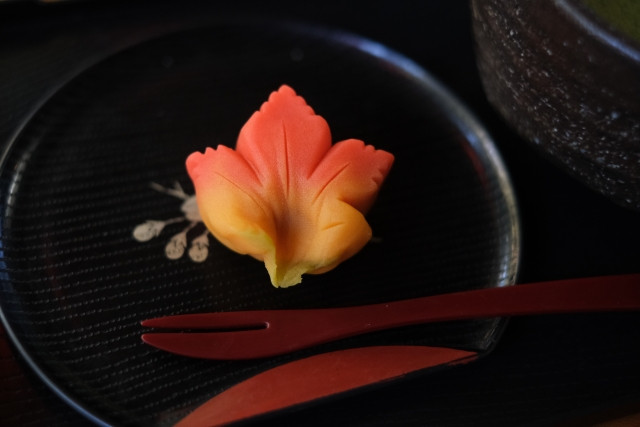
In Japan, there is a culture of enjoying Wagashi in each season. Not only the taste, but the Wagashi’s appearance is made to match the beauty of the seasons. Below, we introduce some Wagashi that are popular in each season.
A Taste of Spring with Sakura Mochi

Sakura Mochi (桜餅) are light pink mochi with red bean stuffing wrapped in salted cherry leaves. They are wagashi that symbolises spring. The history of Sakura Mochi dates back to the Edo period when they were originally served by Buddhist monks to welcome grave visitors. In recent years, it has become customary to eat Sakura Mochi on March 3rd, Dolls Festival, to wish for the healthy growth of young girls.
Wish for Childrens’ Prosperity with Kashiwa Mochi
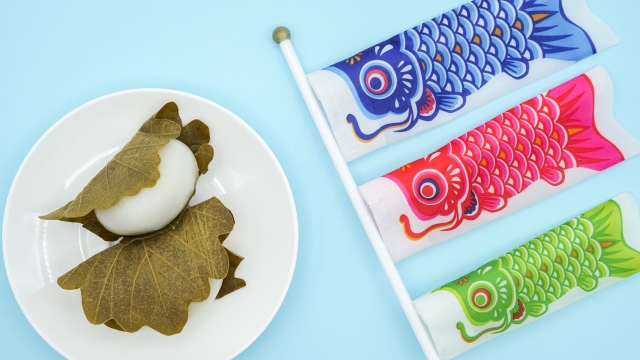
Kashiwa Mochi (柏餅) is a Wagashi made from white mochi wrapped in oak leaves, the mochi is filled with red bean paste or miso paste. It is customary to eat Kashiwa Mochi on May 5th, Children’s Day or Tango no Sekku. Kashiwa Mochi is eaten on this day because the old leaves of oak trees do not fall off until new shoots emerge which symbolises the prosperity of offspring.
Mizu-Yokan for Hot Summer Days
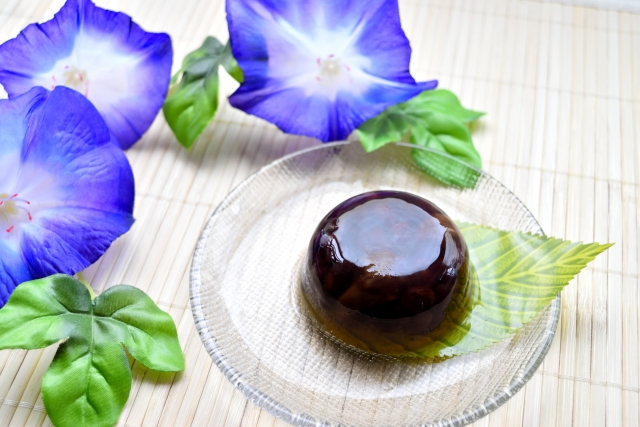
Mizu-Yokan (水羊羹) is a type of Yokan made by hardening red bean paste using agar. Mizu-Yokan has a higher water content than regular Yokan and is characterised by its light and soft jelly texture. It is said to have originated in the Edo period as a dessert added to Osechi. Nowadays, it has become popular as a cooling Wagashi for hot summers.
The Taste of Autumn in Kuri-Kinton

Kuri-Kinton (栗きんとん) is a type of Wagashi made from mashed sweet potatoes and candied chestnuts that originates from Gifu prefecture. Both ingredients are in season during autumn which makes this a Wagashi that symbolises autumn well. The mashed sweet potato and sweetened chestnut mixture is shaped into the shape of a chestnut.
Popular Wagashi to Try
Here, we introduce some of the most popular and classic Wagashi there are.
Daifuku 大福

Daifuku is a Wagashi made by wrapping red bean paste in mochi. The mochi-like texture and the gentle sweetness of the filling makes it popular with children and adults alike. There are many variations of Daifuku, such as “Mame Daifuku (豆大福)”, “Ichigo (Strawberry) Daifuku (いちご大福)”, “Kusa Daifuku (草大福)”, and more. Some daifuku may include custard cream or strawberry instead of red bean paste. The appeal of Daifuku is finding a flavour to your liking.
Mitarashi Dango みたらし団子

Mitarashi Dango are grilled skewered dango with a sweet soy sauce glaze. The sticky dumplings intertwined with the sweet salty glaze gives it a unique exquisite taste. Mitarashi Dango are easily available in supermarkets, so give them a try.
Taiyaki たい焼き

Taiyaki is a type of Wagashi that is shaped like a fish, specifically a sea bream called Tai (鯛) in Japanese, thus the name (Tai)yaki. Dough is used to form the fish and inside is filled with red bean paste. In addition to red bean paste, other taiyaki flavours are cream, chocolate, or other Western ingredients. Taiyaki can also come in different textures, from crispy to chewy. Freshly made hot Taiyaki are the perfect sweet treat for cold winter months. It is said that Taiyaki originated from another Wagashi called Imagawayaki (今川焼き), which was made into the shape of a sea bream to bring good luck and to increase sales.
Warabi-Mochi わらび餅

Warabi-Mochi is soft mochi made from bracken flour (わらび粉; warabi ko / warabi flour) and served with kinako (きなこ; soybean flour) or brown sugar. With a cool, moist texture, warabi-mochi is a well-known summer delicacy, and can be found in shops during early summer.
Ohagi おはぎ ・ Botamochi ぼたもち

Ohagi / Botamochi is made from a mixture of glutinous and normal rice, which is cooked, rolled, and wrapped in red bean paste. The mochi texture, with just the right amount of graininess, and the sweetness of the sweet red bean paste make for a perfect match. Ohagi and Botamochi are basically the same thing, but are called by different names depending on the season.
Botamochi is eaten during the equinoctial week in spring, its name is derived from the peony flower called “Botan (牡丹)” in Japanese. On the other hand, Ohagi is eaten during the equinoctial week in autumn, and is named after the Japanese clover called “Hagi (萩)” in Japanese.
Castella カステラ

Despite its Western appearance, Castella is a Wagashi. A dough formed from a combination of eggs, flour and sugar is baked in an oven to make Castella. It was introduced to Japan from Portugal during the Warring States period and developed into a unique Japanese confectionery. The name Castella comes from the Portuguese reading of “The Kingdom of Castile”, and means that it is a confection made there. Castella is characterised by its fluffy texture made possible with lots of eggs, and the gentle sweetness from the sugar.
Dorayaki どら焼き

Dorayaki is a Wagashi that consists of two softly baked pieces of castella dough with red bean paste sandwiched between them. The name “dorayaki” comes from the percussion instrument called “dora (銅鑼)”. The moist texture and elegant, gentle sweetness is superb. Dorayaki is best known as all-time beloved character Doraemon’s favourite food.
Imagawayaki 今川焼き・Kaitenyaki 回転焼き・Obanyaki 大判焼き
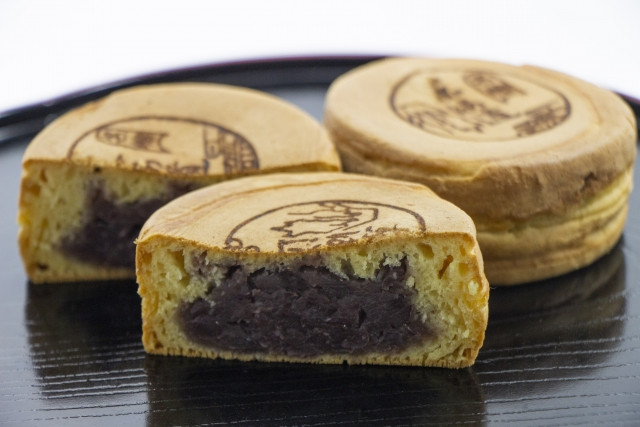
Imagawayaki is a Wagashi made by wrapping red bean paste in a dough made from a mixture of flour and eggs, then baking it. Although the method of making is the same, they are called by different names depending on the shop and regions, such as “Kaitenyaki” and “Obanyaki”. The surface is crispy and fragrant, while the fluffy dough inside matches well with the sweetness of the red bean paste. Other flavours aside from red beans are available these days, like chocolate, cream, jam, and more.
The Modern Take on Wagashi
With the introduction of fancy gorgeous looking Western confectionaries, the younger generations have started to lose interest in Wagashi, some going so far as to describe them as “plain looking and too simple”. Well, Wagashi artisans aren’t just going to take that, and so Wagashi goes through a transformation to keep up with the times.
Many Wagashi artisans have set up accounts on Twitter and Instagram to promote their “new-generation” Wagashi. Wagashi that live up to the traditional taste passed down through the generations, but with a new shiny, elegant, or even cute image.
Okashitsukasa Mansaku - Makes Sweets that Everyone Loves
Established in 1968, this store now makes adorable manjus. Manju (饅頭) is a type of Wagashi that has a soft outer skin and bean paste filling, usually red bean but many other flavours are available too.
ご予約受付2月20日まで
— 御菓子司まんさく∞可愛いおまんじゅう屋さん∞ (@okashi_mansaku) January 26, 2023
2月27日より発送開始です✨
関東風桜もちとひな祭りver.動物饅頭12個入🎎🌸
【お内裏様】パグ・豚(こし餡)
おさる(バナナ餡)
【お雛様】白ねこ・うさぎ(こし餡)
ツキノワグマ(ミルクココア餡)
🟢 https://t.co/YjxvFt8lSD
🟢 https://t.co/SVyD7SjWiC pic.twitter.com/w4Yem6NEzo
Read more about Kawaii Animal-shaped Manjus in our article here.
Beniya Miyake - Nerikiri that Heals Your Soul
Nerikiri (練り切り) is a type of Wagashi made from white bean paste that is easy to mould into various shapes. This store, with a focus on Nerikiri, takes it upon themselves to make edible works of art.
Read more about Super Cute New Generation Wagashi in our article here .
Many people are curious about what these beautiful, adorable Wagashi taste like, but also feel it would be a shame to eat them.
To Close

With a deeper understanding of Wagashi, you can now better appreciate them. Try the different types of Wagashi there are in Japan, and see if you can really appreciate the difference from Western confectionaries. Which suits your taste buds more?



































